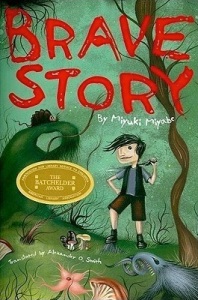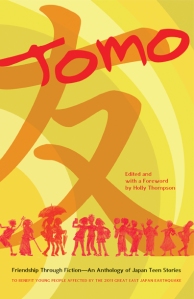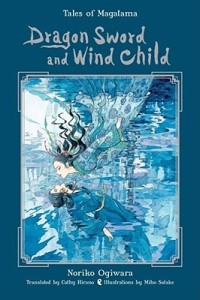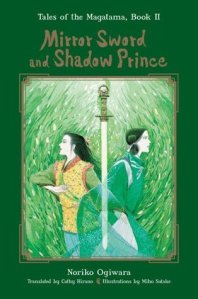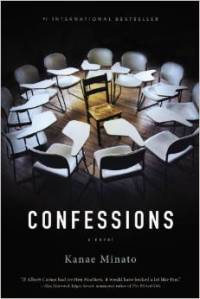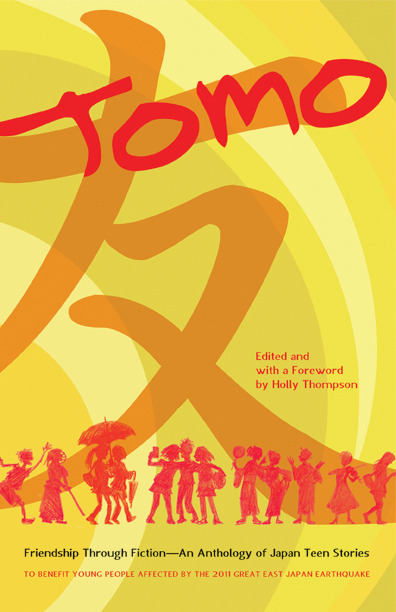By Deborah Iwabuchi, Maebashi, Japan
Juliet Winters Carpenter is well-known for her brilliant translations, and despite her “retirement” to Whidbey Island in the state of Washington, is apparently as busy and productive as ever. Fortunately for this blog, two of her latest books happened to fall into the young adult category, and she kindly agreed to be interviewed. The two books in the title here are also known as the Forest Series, Books 1 and 2. The back matter of the original Japanese version of Tales Told at Night included this snappy synopsis of The Easy Life in Kamusari that definitely serves for both:
A popular title portraying a laid-back youth in the forestry business!
Yuki is 18. After high school graduation, he plans to make a dubious living hopping from one part-time job to the next. But for some reason, he ends up in Mie Prefecture in the forestry industry. He’s out in the mountains without cell phone service! There’s nothing there but hills and dales! Can Yuki make himself into a forester? Pandemonium breaks out on every page of this story about Yuki and the unique people he lives with. (Tokuma Shoten)
Deborah: Juliet, this makes three books you’ve translated for Shion Miura. Can you tell us how you came to translate her books? Have you had any personal contact with her? Did you communicate with her as you did the translation?
Juliet: I came to translate Shion Miura because her novel The Great Passage was featured by JLPP, the Japanese Literature Publishing Project. I was asked to translate the first chapter as a sample for publishers, and a couple of years later, Amazon Crossing picked it up and asked me to do the whole book.
Shortly after the translation came out, just five years ago this month, I had the pleasure of doing a taidan or public discussion with Miura at Doshisha Women’s College of Liberal Arts, before a packed auditorium.

She was fun and smart and I thoroughly enjoyed the experience. That is the only time we ever met in person. While working on Passage, I never did consult with her directly, but the editor and I communicated with her via her agent, mostly about big overall questions like how to present the crazy love letter at the end and whether to include an explanation of the ancient Tale of the Bamboo Cutter, which is alluded to so often in the book (in the end, at Miura’s request, I didn’t explain it). All other translation matters I handled myself. For the Forest Series, too, I worked on my own and didn’t consult Miura except to make sure I was reading people’s names correctly.
Deborah: Have you done books in the YA category before?
Juliet: I guess A Cappella by Mariko Koike (Thames River Press, 2013) could count as a YA book. It’s the story of a woman looking back on a major romance that ended tragically in her high school days, set against the backdrop of the counterculture student movement of the sixties. While that book captures “intense, heartbreaking love in adolescence,” as the blurb states, the Forest books are much lighter, more humorous and optimistic in outlook. I also translated “Fleecy Clouds,” a short love story by Arie Nashiya, for Tomo: Friendship through Fiction–An Anthology of Japan Teen Stories, edited by Holly Thompson (Stone Bridge Press, 2012). Both the Koike book and the Nashiya short story feature teenage girls, so having a male narrator in the Forest series was a fun change.
Deborah: As soon as I started reading The Easy Life, I was impressed by a couple of things. One was that you use Japanese words such as naa-naa, which was in the original title, and others, such as kappa and the totally inexplainable shirikodama—which you neatly described in a few words following. The other was the way Yuki spoke. You used a lot of colloquial American English in his narration, and it worked perfectly to express the 18-year-old cluelessness of the main character. This kept up all the way to the end of the second book. Yuki never got remarkably adult in the way he wrote, and the effect was hilarious. Did the way Miura write it transfer directly into your translation, or did you go about it in a particular way? What else did you have to keep in mind when the things that Yuki was narrating became more complicated—like all that information on forestry?

Juliet: Dialect plays a huge role in defining character and place, and it’s always a bit frustrating not to be able to share those differences fully with my readers; often the best you can do is suggest a certain flavor. Naa-naa works because it’s initially unfamiliar to Yuki as well, so we learn along with him what the word means, how it’s used, and what it tells us about his new community. I didn’t stick naa-naa into the translation every place it comes up in the original, of course. As you mentioned, it’s part of the original title, for example, but using it there in English would be mystifying. However, sprinkling the word in at appropriate junctures, as when Yuki utters it for the first time, worked really well, I thought.
Words like kappa (river imp) and shirikodama (the soul-ball located in the anus) are fascinating and help us to share in Yuki’s other observation about the village––that it’s a place where everyone seems to have “stepped out of a folktale.”
One of the things I played with was characters’ names. The narrator’s name is Yuki, “courage.” He eventually comments ironically on his lack of courage, but in English I decided to provide an explanation early on and squeezed in this sentence in the first few pages: “But I never was much for decisive action, even though my name means ‘courage.’” I also added a disclaimer for the name of the five-year-old boy, Santa, on its first mention: “As I eventually found out, ‘Santa’ is written with characters meaning ‘mountain man’; no connection to reindeer and elves.” I felt that Anglophone readers would be surprised at the Christmassy-sounding name, even if Japanese readers were not. (In Japanese, the visual impact of kanji trumps pronunciation, making it unlikely that readers would make any association with Christmas.) I was pleasantly surprised to find that much later, at the end of Book 2, they actually throw a Christmas party to please little Santa, and he even gets a letter from Santa Claus commenting on the similarity in their names!
I took some other name-related liberties. Yuki lives and works with a guy named Yoki, which means “ax”; that is kind of a cool name in English, too, so I toyed briefly with the idea of calling him “Ax,” but ended up keeping the original name despite the similarity to “Yuki.” However, Santa’s mom is “Yuko” in the original, and that was just too much. Again, as kanji trump pronunciation, the three names do not strike Japanese readers as all that similar, but written in the alphabet, they are too close for comfort. Yuko was rechristened “Risa.” I altered a couple of other names as well, hoping to spare the reader confusion.
As for Yuki’s way of speaking, it needed to sound young, urban, and contemporary, as different as possible from the villagers. I knew what I wanted him to sound like, and I enjoyed finding ways to do it. On his first night in Kamusari, he is served the exotic (to him) dish of wild boar stew. At first, I rendered Yuki’s comment literally: “I was eating wild boar stew.” The editor suggested cutting the line as stating the obvious, but I wanted to keep it because it reflects his amazement at his unfamiliar new surroundings. I came up with “I was legit eating wild boar stew,” which adds clarity to the moment and to Yuki’s persona.
For forestry terms, I searched online and read up about forestry all I could. At first, I intended to retain more Japanese technical terms, but since there were English equivalents, I dropped that idea. Forestry is forestry, and using Japanese terms didn’t seem to serve any useful purpose––except for those denoting which way a felled tree will land. The first time he hears them, Yuki has no idea what they mean, so I left those in Japanese and explained later with glosses. The most interesting one was shombentare, for a tree that comes crashing down straight forward. Shomben tareru is the verb “piss,” but I needed something more, so I expanded it to “piss-pants.” Soon after, Old Man Saburo comments to Yuki, “A shombentare will make you piss your pants, no mistake.”
Deborah: The details on forestry, the myths of the gods, and the elaborate customs of the villagers. I felt as though the book could be used as a text on traditional Japanese culture. Yuki was like a foreigner coming to Japan with no idea of how things worked. Then I thought of my Japanese friends in Tokyo who have had so little contact with the traditional side of things here. I’m imagining the Japanese readership learned a lot from these books too. Do you think Miura was writing to educate them on the value of life outside of the big city?
Juliet: I completely agree that Yuki is like a foreigner new to Japan, surprisingly clueless about all things traditional and highly skeptical of references to gods and spirits–until he isn’t. Of course, since many readers of the English edition will in fact be foreigners with no idea of how things work in Japan, that POV came in pretty handy. I am sure that these books do contain revelations for today’s Japanese, who have so little contact with or awareness of life in places like Kamusari. As Miura shows, villages are withering as young people depart, leaving no one to carry on the work of tending forests or growing rice. It’s heartening to see Yuki gradually falling in love not just with Nao but with all aspects of life in Kamusari, surrounded by lush nature, and to see his growing ability to respect and honor village traditions. Miura’s own grandfather was a forester, and perhaps these books are her tribute to him and his way of life.
Deborah: Did you have a favorite character? Were there any scenes that you particularly enjoyed doing?
Juliet: A lot of the characters appeal to me. One I particularly like is Noko, Yoki’s faithful dog. I was tickled by the scene where they restore Noko’s self-respect by staging a show for his benefit, allowing him to play the hero by “saving” Yoki. I love dogs and it was fun translating Noko’s thoughts, like this bit of Eeyore-like moping: Ah, it’s the young master come to call, I see. I’m sorry, but please just leave me alone. The scene adds a refreshing bit of humor, and it deepens Yuki’s––and our––attachment to the people and the place. As Yuki says, “Kamusari village, a place where grown men had in all seriousness just put on a show for the sake of a dog. A place that was growing on me more all the time.”
Deborah: Let’s talk about that festival at the end of The Easy Life. I really felt like Book 1 was a man’s book about men. Yuki worked with Yoki, who fooled around on his wife and could swing from tree to tree in the forest as he cut down trees with one hand tied behind his back, his loyal dog by his side. Then that scene of the big festival on Mt. Kamusari. It was so full of phallic symbols and testosterone, and it went on and on. What were your impressions while translating it?
Juliet: The festival at the end of Book I––whee! It’s pretty wild all right. And yes, unabashedly phallic. There actually are festivals that involve riding logs down a steep mountainside, going way back, so this is not just Miura letting her imagination run away with her. The ongoing Onbashira Festival is said to date back 1200 years to Heian times. [Note from Deborah: Go to the Onbashira Festival link and scroll down the photos. This is what we’re talking about here!] Miura ties many strands in the novel together in the exciting finale as goddesses hover over our hero and others, protecting them from disaster (lives are regularly lost in the Onbashira Festival). Yoki yields his position as medo––one supposedly having the right to sleep with a village girl of his choice––to Yuki, who has proved himself brilliantly. Cheered on by his teammates and surrogate family, Yuki uses his newly acquired status to work up the nerve to… ask Nao on a date. She agrees, but tells him not to get any funny ideas. So after all the high-flying shows of masculinity, it comes down to a simple, respectful request from a boy in love, and a cautious “yes” from a young woman still weighing her options, and still nursing a love of her own.
Deborah: Tales Told At Night is somewhat less about forestry and men, and more about the myths and practical applications of the mountain gods. Granny Shige comes to the fore with her computer skills, storytelling, and problem solving. Yoki’s wife Miho has tasks other than throwing crockery at her husband and making lunches. Nao, Yuki’s love interest, is a woman with a mind of her own. Any thoughts on the shift between the two books?
Juliet: Tales Told at Night carries on from there, giving us a deeper look at Nao, Miho, and Granny Shige, as you say, but not only them; we also get Old Man Saburo’s backstory, not to mention Yoki’s. We even learn more about odd Mr. Yamane. In general, the characters are deepened and the ties between them become stronger. I loved the midnight scene between Yuki and Yoki on the mountainside. Yoki tells about the tragic accident that killed so many villagers, including his own parents, and shares his regrets, while Yoki shares his fears about not really belonging, not having a tie to Kamusari as indelible as that of native villagers. It’s moving to see this pair of manly men open up to each other, reveal their frailties and vulnerabilities. Miura deftly rounds out her characters and makes them human, relatable.
That said, of the remaining characters, several remain less well defined. We do learn where Iwao lives and that he doesn’t like tomatoes, so I guess that’s something, but his poor wife doesn’t even have a name. Risa, meanwhile, remains a model wife and mother. I confess I wonder why she doesn’t have more children, since Santa’s only playmate in the village is Yuki, and depopulation is such a dire problem. She and Seiichi are well off, and they live in that big house. Anyway, it never comes up. Yoki and his wife are childless. In the movie version, Wood Job, they are trying to conceive without success. Somehow the overabundance of testosterone in the story doesn’t seem to be producing results!

Book 2 also shows Yuki’s progress in accepting village beliefs. When he hears about the deadly accident, he immediately says a quick, non-ironic prayer of thanks to the god of Kamusari for allowing Granny Shige to live a long life and watch over Yoki. In fact, there is a complete switch from Book 1. There Yuki was a skeptic who scoffed at the idea of children being spirited away, for example, claiming it was “unscientific.” But in Book 2, once Nao’s missing pen turns up, he becomes convinced that the god Inari can actually work wonders, only to have his teammates scoff and assure him it was just a coincidence. Miura turns things around nicely again, however, as Yuki learns that belief in Inari motivates thieves to repent of their actions and unobtrusively return “lost” objects. The old beliefs still have power to do good; the god Inari lives on in people’s hearts. And so despite his disillusionment (“like a kid who found out there’s no Santa Claus,” Yoki teases him), Yuki ends up replacing the worn-out torii at the Inari shrine in token of his gratitude. He has truly adopted village ways.
Deborah: Is there a Book 3 in the works for the Forest Series?
Juliet: There is no Book 3 in the works that I know of, but if one comes along, I am game to translate it!
Deborah: Juliet, you’ve been a translator for so long and your unending list of publications speaks to the fact that writers and publishers want you. I’ve read a number of your books and loved them all. Thinking about it, I feel that maybe your crowning skill is in how close you manage to get to your material and are still able to express it beautifully in English. I definitely get pulled into anything I translate, but then I have to take a step back when I’m finished so I can edit and smarten up the English. Once at an SCBWI translation event, the subject came up of whether to stick to the original text or adjust it to make it easier for an English-speaking readership to understand. You said you usually decided to trust the readers to figure it out—meaning you were true to the original. In my mind, I was screaming, “No! Don’t trust anyone!” but now ten years later, I’m wondering if that might actually be the key. Any thoughts on that?
Juliet: Thanks so much for your kind words. I confess when I translate something, I feel a little like Yuki, writing with potential readers constantly in mind yet half afraid no one will ever read what I write! It’s wonderful to be reminded that there are still real readers like yourself around.
As for your question about trust, I would say you trust not just any reader, but the specific one you have in mind, the one you are writing to and for. That reader won’t be the same with every project, but once you have settled on a reader, yes, you should show some trust! The reader isn’t a dimwit after all.
The translation process you describe is exactly the same as mine. Translation is a constant dance with the original, now drawing close to it, now pirouetting away, now coming back again. An endless dance. Maybe the goal is to hear the same music, dance to the same beat as the author. I take a kind of musical approach to translation in general––perhaps the real fruit of my piano lessons with the formidable Jasna Bjankini from sixth grade through twelfth. She urged her pupils to learn the music on the page so that it was in our bones, and then to express it with what she called “zambo”––an indefinable, elusive quality that gives zest and life to a performance, keeps it from sounding wooden or merely virtuoso. And if the music is in your bones, you won’t go off the rails (a performer’s worst fear).
An aside, my brother Glenn Winters, who also studied with Jasna and won numerous gold medals in piano contests as a child, is now a composer of opera among other things. I reminded him of zambo and he commented modestly, I only occasionally achieved it, though I tried.
I would like to throw in a word of admiration for Brian Nishii, who performs all of Miura’s works so brilliantly for audiobooks. He does a wonderful job! His rendition of The Great Passage won an Earphones Award for fiction. Brian is a masterful narrator and it’s great fun to hear him bring characters and scenes to life. I urge people to give his work a listen.

Deborah: I listened to Brian Nishii’s versions of both The Great Passage and The Easy Life in Kamusari, too. Both were great reading experiences. I especially enjoyed the chapter about the big Kamusari festival. As Brian read it, I just closed my eyes and watched the scene play out in my mind. I found it even more fun than reading the text. (As of this writing, the audiobook version can be added for a modest price when you download the book on Kindle.)
Juliet, thank you so much for joining us here to share insights on the books and your creative process! I’m looking forward to your next translations.










